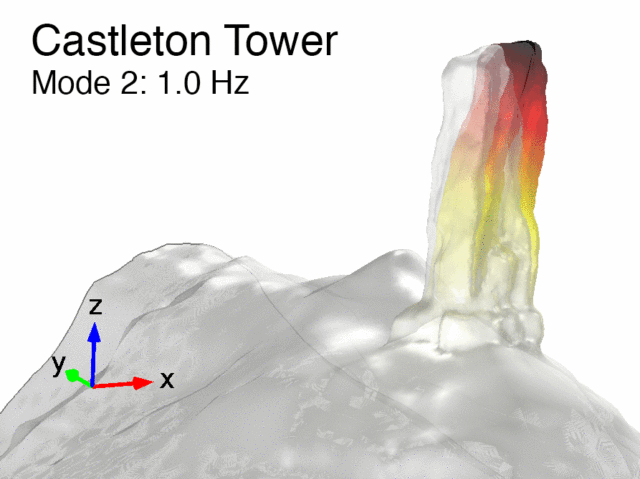Popular Utah rock-climbing spot vibrates in time with earth, wind, and waves

Scientists at the University of Utah have made the first detailed seismic measurements of a pillar-shaped sandstone formation in Utah known as Castleton Tower. [corrected] The structure vibrates at two key resonant frequencies, according to a new paper in the Bulletin of the Seismological Society of America. That means it’s likely to withstand earthquakes of low to moderate magnitudes. The methodology the Utah team developed can also be applied to other natural rock structures to determine how vulnerable they are to seismic and other similar activity.
“We often view such grand and prominent landforms as permanent features of our landscape, when in reality, they are continuously moving and evolving,” said co-author Riley Finnegan, a graduate student at the University of Utah. “Because nothing is truly static, there is always energy propagating throughout the earth, which serves as a constant vibration source for the rock.”
The research team has an entire webpage devoted to its seismic recordings of the natural resonances (vibrations) that come out of the Utah arches. The arches are the impressive red rock formations, about 10 miles from the town of Moab, and the team has sped up the recordings into audible sound. Those structures can bend, sway, and shake in response to any number of factors: wind gusts, distant seismic tremors, thermal stresses, local traffic, and so forth. The arches often amplify the energy passing through them if the frequencies are just right. Understanding those dynamics is crucial to being able to predict how the structures will respond in the event of an earthquake or similar disruption. Yet there haven’t been many ongoing efforts to do so over the years, despite a great deal of research on manmade civil structures.
One of the major challenges to studying the arches is gaining the access necessary to make those vibrational measurements in the first place. Either the formations are restricted (the better to preserve them for posterity), or it’s simply too difficult to place sensors in hard-to-reach spots on the formations. That’s what makes this new dataset of ambient vibrations from the 120-meter (393-foot) Castleton Tower so significant.
“As of just a few years ago, there were almost no measurements of this kind in existence,” said co-author Jeff Moore, a University of Utah geologist who led the study. “So every feature we measure is something new.”

Finnegan and his colleagues managed to collect their data with the help of two experienced rock climbers. They were able to climb the tower and place seismometers in key spots: at the base of the structure (to serve as a reference) and another at the top. The climbers stayed with the instrument for three hours as it recorded data, then climbed back down to return it to the researchers.
The Utah team already knew from prior work that the unique geometry of taller structures like Castleton Tower will vibrate at lower-resonance frequencies than smaller ones—much like thick guitar strings have lower pitches than thin ones. The researchers’ analysis showed two strong, distinct peaks in the data at 0.8 and 1.0 Hz, respectively, which they identified as the structure’s first two resonant frequencies. That makes the structure vulnerable to strong-magnitude earthquakes, which are fortunately quite rare in the region. Smaller quakes—or minor vibrations from traffic, construction machinery, or other environmental factors—are unlikely to trigger the natural resonances of the tower.
That said, “While some forces humans create might appear minor, our research is addressing the long-term effects of these forces on the rate of erosion and structural degradation over time,” said Moore. The model he and his students developed for Castleton Tower should also be applicable to other natural rock formations, taking into account such factors as height, slenderness, and material composition. That will help monitor any changes in structural integrity over time.
“I hope that climbers and anyone who is fortunate enough to stand in the shadow of this stone giant will see it in a new light moving forward,” said co-author Paul Geimer, another Utah graduate student. “As with the desert landscape in which it resides, Castleton Tower is dynamic and energetic, subtly responding to changes in the surrounding environment.”
DOI: Bulletin of the Seismological Society of America, 2019. 10.1785/0120190118 (About DOIs).
https://arstechnica.com/?p=1558165